When we pass the sign displaying ‘Arsenale’ on the road from Fornaci di Barga to Castelvecchio Pascoli in the Garfagnana I am always wistfully reminded of a part of London I know rather well. It’s Woolwich with its former Royal Arsenal, the armaments powerhouse of the British Empire, now being redeveloped as a prime residential area.
‘Arsenale’ is one of the four contrade or quarters of Barga, the others being Ponte di Catagnana, Catagnana and San Quirico. I don’t know whether its name alludes to a former armaments factory. The Woolwich ‘Arsenal’, however, has a long history connected with the testing and manufacture of the lethal weapons of war. Its origin dates from the 17th century and by the time of the First World War its area had expanded to over a thousand acres and it employed over eighty thousand people. Ceasing production in 1967 the Arsenal finally closed in 1994 when the Ministry of Defence moved out.

(Women workers at the Royal Arsenal during World War One)
The area used to be top-secret and was not marked on any Ordnance Survey maps. I remember we had to sign the Official Secrets act when we visited the Arsenal in a specially hired bus since the area was so extensive. Later I would explore the abandoned site with its decaying armaments factories ammunition proofing sheds and explosives research laboratories. Regrettably I have few photographs in a pre-digital age of the complexities of the area except for these. They have become ever more valuable to me. Spot the large hangars, the rifle testing tunnel, the anti-Hitler casements (an attack up the Thames was imagined) and the remains of the Royal Arsenal rail network.
I also penned this poem in recognition of the strange wonders the domain held me when it was still in its derelict state.
THE OUTER ARSENAL 1985
These steep arched banks, like iron-age forts, protect
the engines of war. Through white-tiled tunnels
(for in making bombs one cannot neglect
pureness) we reach a field of wrecked funnels.
Past the birches gulls land on the tump, spread
gently like a park’s ornamental pond.
At its centre, the island of the dead:
a walled garden stilled by alchemy’s wand.
Wasteland runs riot: spinneys and briars
grow from Victorian ruin and sprout fruits;
while above a lark sings in heaven’s choirs
on the tarn’s a confutation of coots.
This land was ours and we could walk it free:
reclaim love from war before new blight’s scree.
Since those days most of the old Royal Arsenal site has been redeveloped for housing as part of Thamesmead’s expansion. Gone is the abandoned area with its characteristic tumps, moated mounds once storing explosives. There is little evidence of the former railway network which serviced the various armaments production centres.
Much of the wall surrounding the complex has gone because of road widening. In their place new housing and commercial centres are springing up – certainly a more positive aspect when compared to the area’s previous dedication to destructive weapons.
However, the original part of the Royal Arsenal has been preserved for its historical value. It contains several buildings of some worth.
The main gateway is now separated from the rest of the arsenal by a widened road and stands alone as part of Woolwich Market.

Here is my photo taken of when it was being isolated from the arsenal it prologued. Note the former wall which joined it to the site.

Crossing the road and entering the depot’s grand avenue the following features attracted my attention:
The elegant Royal Brass Foundry of 1717:

Dial Square is where what was to become Arsenal Football club played its first game.

I was particularly taken by the mock cannon balls adorning the portico of the building here.

The Main Guard House dates from 1787 and provided accommodation for an Artillery detachment.

The original Royal Military Academy designed by Vanbrugh in 1718 once served as the Royal Arsenal Officers’ Mess. I tried to take photographs of this building’s interior but was requested to leave by a security guard. Presumably it still houses top-secret activities!

The riverside guard rooms of 1815 mark the arsenal’s main entry point from the river. It was here that the body of ‘Lulu’, the Prince Imperial, son of Napoleon III, was brought after his death in the Zulu wars. Queen Victoria on her visit to Woolwich insisted on being brought to this very spot. You can read more about this in my Facebook entry at https://www.facebook.com/fpettitt/posts/10214823717241037.

By the guard houses is a group of Gormley-like statues by sculptor Peter Burke called ‘assembly’. I think they just about respected social distancing!
There are several other historic buildings many of which have been converted into luxury riverside flats or community centres. It’s good to know that redundant historic structures are now being recycled to other uses instead of being demolished as they formerly would have been.
I walked part of the London stretch of the 184 mile long Thames path which passes various various piers, one of which had been re-utilized as a Thames river-bus stop.
The path took me to the new housing development of Thamesmead. As Battersea is now renamed ‘South Chelsea’ by resident snobs so West Thamesmead is now called ‘Broadwater Green’ perhaps to dispel its former notorious past as the scenario for Stanley Kubrick’s controversial ‘A Clockwork Orange’.
Many of the 1960’s brutalist pseudo-Corbusier blocks of flats have now been demolished and replaced by more friendly housing. Some of the high rise buildings, which made our yachting sorties on the lake fronting them somewhat dodgy because of their wind deflection propensity, still remain, however.
I was pleased to note that a new Thamesmead was rising with ample green, a multitude of trees and the preservation of many of the tumps and canals which characterised the old Arsenal site. It was quite lovely to enjoy the warmest of suns in this landscape of willows, lakes, coots and swans.




















































































































































































































